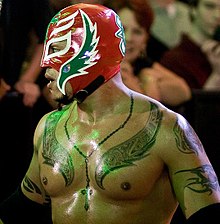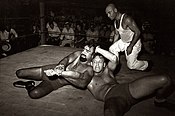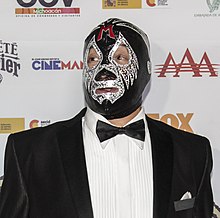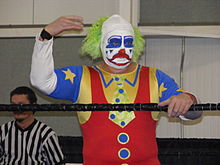Gimmick (professional wrestling)
This article needs additional citations for verification. (January 2022) |

| Part of a series on |
| Professional wrestling |
|---|
 |
In
Promotions will use gimmicks on more than one person, albeit at different times, occasionally taking advantage of a masked character which allows for the identity of the wrestler in question to be concealed. Razor Ramon was portrayed by both
Gimmicks are annually rated for the Wrestling Observer Newsletter awards by the publication's owner, professional wrestling journalists, and various industry insiders, such as Dave Meltzer, promoters, agents and performers, other journalists, historians, and fans. The two awards are given to the best and worst gimmick of that year.
History

Beginnings (1860s to 1940s)
Pro wrestling's history has been tied to the use of gimmicks from its infancy. From its circus origins in the 1830s, showmen presented wrestlers under names such as "Edward, the steel eater", "Gustave d’Avignon, the bone wrecker", or "Bonnet, the ox of the low Alps" and challenged the public to knock them down for 500 francs.[1]
During the late 19th century-early 20th century, when wrestler Frank Gotch rose to prominence, the focus became on contests largely legitimate (see catch wrestling), which largely resulted in the abandoning previous character gimmicks.
Television era (1950s to 1970s)
It was not until the First Golden Age of Professional Wrestling in the United States during the 1940s–1950s, when Gorgeous George created pro wrestling's first major gimmick. His heel character focused on his looks and quickly antagonized the fans with his exaggerated effeminate behavior, drawing jealousy to the fans. Such showmanship was unheard of for the time; and consequently, arena crowds grew in size as fans turned out to ridicule George.[2]
Gorgeous George's impact and legacy on wrestling gimmicks was enormous, demonstrating how fast television changed the product from athletics to performance. Before him, wrestlers' gimmicks imitated "ethnic terrors"—Nazis, Middle Eastern Muslims (Arabs, Turks, Persians, Afghans, etc.), Japanese, Russians, etc.—but his success birthed a more individualistic and narcissist form of character.[3]
He was one of the first pro-wrestlers to use entrance music, "
In Britain, television took British wrestling to the next level when in 1964, it went full-time as part of the
The style of wrestling at the time was unique with strong emphasis on clean technical wrestling. Heels made up a minority of the roster, with most shows containing an abnormally high proportion of clean sportsmanly matches between two "blue-eyes" (as faces were known backstage in the UK). This would remain the case for several decades to come. Gimmick matches were a rarity, midget wrestling failed to catch on, while women were banned by the Greater London Council until the late 1970s.
Explosion (1980–present)

During the
The WWF contributed to the explosion of gimmicks by becoming the most colorful and well-known wrestling brand because of its child-oriented characters, soap opera dramatics and cartoon-like personas. Most notable was the muscular Hulk Hogan, who marked the 1980s with his "Real-American" gimmick and made his main events into excellent ratings draws. His dominant role in the industry at that time led to this era to be also known as "Hulkamania". Around this time, wrestling became a form of entertainment rather than an official sport.
Other wrestlers from this era with similarly vivid and outlandish characterization include
Following the Attitude era, the emphasis of gimmicks has been more realistic with wrestlers portraying themselves or actual people without the exaggeration, freakishness or fantastical qualities. It is also more common for the wrestlers to use their actual names. Wrestlers like Randy Orton, Batista, Bobby Lashley, John Cena, and Brock Lesnar are prime examples. All the said wrestlers are depicted as less-exaggerated average people.
Although rare, colorful and cartoon-like characters remain in the WWE, such as Shinsuke Nakamura (a wildly random, erratic mixed martial arts enigma, emotionally charged by the sound of violins) and Matt Riddle (a stereotypical carefree, barefoot surfer Valley boy).[5] Outside WWE, some wrestlers have made names for themselves on the crowded independent circuit by adopting absurdist comedy gimmicks intended to be understood by post-kayfabe fans as purely fictional characters. Two such wrestlers whose independent-scene popularity got them noticed and eventually signed by the internationally televised promotion All Elite Wrestling are Orange Cassidy, an emotionless slacker who puts as little effort as possible into his matches and frequently wrestles with his hands in his pockets; and Danhausen, a demonic but somewhat-bumbling figure in horror face paint who claims to be "very nice, very evil" and attempts to put curses on his opponents.
Common gimmicks
Related to origin
Exaggerating the characteristics of a wrestler's (on occasion
A long list of wrestlers in this category includes: Arab (
Masked

Masked wrestlers made their appearance in Europe (
A specific masked gimmick may be used by more than one wrestler at a
Other wrestlers who have used masks in their performances include:
Sports
A high number of wrestlers who start their careers in another sport incorporate their athletic abilities as part of their act. That is the case for Olympic medallist
Superheroes, supervillains and other comic-based characters

The theatrical nature of professional wrestling easily blends with comic hero and villain characters, made popular in the 1980s by legend The Ultimate Warrior and Sting, whose character was inspired by the 1994 movie The Crow, based on the comic book of the same name.
Other wrestlers with superhero and supervillain gimmicks include late
Some of these characters are brought during very short periods of time for entertainment value.
Supernatural-based characters

Similarly to superheroes and supervillains, supernatural characters add to entertainment value. Most famously in this category is
Other wrestlers displaying supposed supernatural powers include
Raven was the leader of five stables; Raven's Nest, The Flock, The Dead Pool, The Gathering, and Serotonin.
Alexa Bliss was also given a different gimmick after her alliance with Bray Wyatt in late 2020s, appearing suddenly and sometimes attacking the other wrestlers, the same things that Bray Wyatt would do.
Juggernaut
Since its beginnings in the circus circuit, the professional wrestler's stereotype has been that of large, powerful and strong, most notably Kane upon his arrival to the WWF/E. Various wrestlers have banked on the larger size which has influenced their in-ring style and persona.
Notable examples of these kind include Swede
Midget
Similarly to juggernauts, since its beginnings in the circus circuit, the professional wrestler's stereotype has been that of small, but powerful and strong like those of
Notable examples of these kind include the leprechaun Hornswoggle, El Torito and other various dwarfed versions of other various wrestlers.
Educational
Education is a rare gimmick in wrestling due to the fact that, most times, the wrestler is a former
.Bad News reporter
Bad News reporter characters are a villainous gimmick; due to any "bad news" reported to the fans by a "bad guy" (heel); but is quite rare since that fans are not quite interested in it either. Wrestlers who used this gimmick include
Religious
Religion is often a rare gimmick in professional wrestling due to its controversial nature. Wrestlers who used this gimmick include Friar Ferguson, and most recently, "Bolieve" Bo Dallas, and "The Monday Night Messiah" Seth "Freakin'" Rollins.
Hardcore technician
Whilst being way beyond over the limit from some sheer violence is scary in some matches, hardcore technician gimmicks are also another popular choice for gimmicks, due to the fans being
Music-based characters
Music influences are another popular choice for gimmicks. In the 80's, The Honky Tonk Man worked with a Elvisesque character.
Comedy

Whilst humor has long been present in professional wrestling matches and many wrestlers incorporate elements of comedy in their act, full-on comedic gimmicks are not commonly seen. These are sometimes reserved for wrestlers who not always have the stereotypical physique required in the industry and instead exploit their entertainment abilities.
Initiated by English wrestler
Charity
Characters who do charity are depicted as a heroic gimmick due to real-life charity. Wrestlers who used this gimmick include Sweet Daddy Siki, Brother Love, "Make a Difference" Fatu, Dude Love, and most recently, "The Doctor of Hug-o-nomics" Bayley, and tag-team Men on a Mission.
Self-absorbed
Usually a villainous gimmick, initiated by
Hollywood movie star
Hollywood movie stars are occasionally villainous due to fame outside of wrestling as a real-life
Authority figure-based characters

Authority figures are apparently villainous but sometimes as heroic characters as wrestlers and non-wrestlers (e.g.
Money-based characters (Evil billionaire/Millionaire tyrant)
The evil billionaire/millionaire tyrant character works well as a villain — due to the jealousy of the fans who want the things "money can't buy" for themselves which they can't afford — in contrast to professional wrestling's
The original gimmick of this type was created by
Ruthless ruler
Similarly to evil billionaire/millionaire tyrant characters, and even authority figures, ruthless ruler characters are mostly a villainous gimmick based on
Hated crime gang/Terrorist thugs/Bad guy bandits/Mafia mobsters
Hated crime gangsters, terrorist thugs, bad guy bandits, mafia mobsters etc. all work well as a villainous gimmick due to
Other usage
- Within professional wrestling in insider usage the word 'gimmick' has come to refer to an array of other related terms, including any weapon or foreign object used during a match or the scripted quality of a match.[7]
- In backstage lingo, gimmick is also a stand-in for basically any physical noun or set of moves in a match.
- Gimmicked is used to describe an object that is altered or rigged for use in a match. For example, a gimmicked table or chair which would be precut or made to fall apart more easily.[8]
- An event that is referred to as a gimmick event is one that is centred around a match type, such as the WWE TLC: Tables, Ladders, & Chairs.[9]
- The term is also a euphemism for hormone-enhancing drugs, namely steroids and growth hormone, which have historically been linked to the sport.
- It has also been used by people in the profession to describe casual marijuana use, as wrestlers will refer to 'smoking the gimmick'.
See also
References
- ^ "History of Wrestling - United World Wrestling". unitedworldwrestling.org. Archived from the original on 2016-03-27. Retrieved 2016-02-08.
- ^ Thesz, Lou. Hooker. p. 100.
- ^ Assael, Shaun. Sex, Lies, and Headlocks. p. 11.
- ISBN 978-1429647892.
- ^ ""CHARACTER" ACTORS - Jim Cornette.com". jimcornette.com.
- ISBN 978-0-7566-4190-0.
- ^ Shoemaker, David (13 August 2014). "Grantland Dictionary: Pro Wrestling Edition".
- ^ "Wrestling Dictionary of Terms".
- ^ Ferrer, Mike (August 2, 2012). "What is it that differentiates classic PPVs from "Gimmick PPVs"?". Súper Luchas (in Spanish). Retrieved January 21, 2022.
